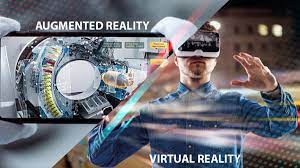


In recent years, the fields of Virtual Reality (VR) and Augmented Reality (AR) have transcended the realms of gaming and entertainment to make a profound impact on healthcare. These cutting-edge technologies are revolutionizing medical training, patient care, and treatment methodologies. From virtual medical simulations that train healthcare professionals to innovative pain management techniques, VR and AR are reshaping the healthcare landscape in ways previously thought impossible. This article explores the potential applications of VR and AR in healthcare and the transformative benefits they offer.
Enhancing Medical Training and Education
Medical training has historically relied on hands-on experience, but VR and AR are changing the game. Virtual Medical Simulations, powered by VR, allow medical students and professionals to immerse themselves in lifelike scenarios. Surgeons can practice intricate procedures, nurses can refine their patient care skills, and emergency responders can hone their crisis management abilities – all within a safe and controlled environment. These simulations bridge the gap between theory and practice, fostering confidence and expertise without compromising patient safety.
Moreover, AR has enabled a new era of anatomy visualization. Complex anatomical structures can be superimposed onto real patients’ bodies, aiding medical learners in grasping intricate relationships with unprecedented clarity. Medical students can interact with virtual organs, examine their functions, and dissect digital anatomical models, enhancing their understanding and retention of crucial medical concepts.
Revolutionizing Pain Management
For patients undergoing medical procedures, pain and anxiety are significant challenges. VR has emerged as an innovative pain management tool by providing distraction techniques. By immersing patients in soothing virtual environments – be it a serene beach or a tranquil forest – their attention is diverted from the procedure, leading to reduced pain perception and anxiety levels. This method offers a drug-free alternative for pain relief, demonstrating the potential of technology to improve patient experiences.
Additionally, VR can be harnessed for mindfulness and relaxation. Patients coping with chronic pain can escape their discomfort by engaging with virtual environments designed to promote relaxation. Through mindfulness exercises and calming visual experiences, VR serves as a therapeutic tool for managing pain and stress, contributing to overall well-being.
Empowering Rehabilitation and Physical Therapy
The applications of VR and AR extend to rehabilitation and physical therapy. Customized rehabilitation exercises can be created using VR, making the recovery process more engaging and motivating. Patients recovering from injuries or surgeries can perform exercises within virtual environments tailored to their needs. These exercises not only aid in regaining motor skills but also provide a novel approach to rehabilitation that captures patients’ interest.
Patients with neurological conditions benefit from AR’s real-time feedback during exercises. By overlaying visual cues onto the real world, AR enhances coordination and movement, thereby assisting patients on their journey to recovery. This personalized approach to rehabilitation could redefine the way neurological disorders are managed.
Revamping Patient Education
VR and AR have the potential to transform patient education. Complex medical concepts can be visualized through interactive 3D models, animations, and simulations, simplifying information for patients. These technologies facilitate better understanding of conditions, treatment options, and procedures, empowering patients to make informed decisions about their health. Surgeons can employ AR to educate patients about surgical procedures. By overlaying digital information onto a patient’s body, intricate surgical processes can be explained with visual clarity, demystifying complex procedures and fostering a stronger patient-doctor relationship based on trust and understanding.
Advancing Telemedicine and Remote Collaboration
The digital age has witnessed the rise of telemedicine, and VR and AR are enhancing remote medical interactions. AR enables doctors to virtually examine patients by annotating real-time visual data, providing accurate diagnoses and guidance. Remote consultations become more immersive, allowing medical professionals to assess patients from a distance. Moreover, VR and AR are facilitating remote training and collaboration among healthcare experts. Surgeons can consult with specialists in different geographic locations, sharing their expertise and insights seamlessly. This digital collaboration accelerates decision-making, ensuring patients receive the best possible care regardless of their location.
Addressing Phobias, Anxiety, and Cognitive Rehabilitation
Beyond physical health, VR and AR offer solutions for mental health challenges. Exposure therapy, a proven method for treating phobias and anxieties, can be conducted within VR environments. Patients can confront their fears gradually in a controlled setting, making the therapeutic process more effective and comfortable.
Individuals with social anxiety can benefit from VR’s social interaction practice. By simulating various social scenarios, patients can build confidence and improve their social skills, ultimately leading to enhanced real-world interactions. Furthermore, VR applications are emerging as tools for cognitive rehabilitation.
Patients with cognitive impairments or neurodegenerative disorders can engage in memory and cognitive training exercises within virtual environments. These exercises stimulate brain activity and help maintain cognitive functions, improving patients’ quality of life.
The convergence of Virtual Reality and Augmented Reality with healthcare is unlocking a multitude of opportunities to revolutionize patient care, medical training, and therapy. From lifelike medical simulations to pain management techniques and patient education, these technologies are reshaping the healthcare landscape for the better.
As the potential applications of VR and AR continue to expand, healthcare professionals, patients, and researchers alike stand to benefit from a new era of innovation and transformation. The future of healthcare is being reshaped by these immersive technologies, promising a world where medical excellence and patient well-being converge like never before.